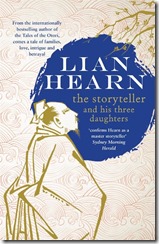Lian Hearn has been recommended to me on a number of occasions by a number or people who know my tastes and hobbies. I can’t for the life of me figure out why I haven’t taken them up on the recommendation. Perhaps it’s my reaction to hyped up books and authors (I still haven’t read Harry Potter).
Sometimes other people do know you best.
Hearn is most well known for her immensely successful Tales of the Otori series, a fantasy series inspired by pre-modern Japan. The Storyteller and his Three Daughters, however is a historical fiction set in late 1880’s Tokyo.
This book is deceptive in the best possible way. Unassuming, quiet, steadily paced it ingratiates itself with the reader and before you know it we have gone from a tale about an aging and unhappy storyteller, to a tale of brutality and political intrigue.
There’s a skilled hand at work here, a lightness of touch in the telling of the tale. It also paints an evocative and realistic (as far as I can tell) picture of Japan in the throws of cultural crises, the fall of the Shogunate and the effect of the European colonial powers plying their culture and interests.
Not afraid to experiment, Hearn presents the dialogue in the book as it would be rendered in early novels of the Meiji era i.e. like a play script. This may pose some issues it you are particularly attached to conventional dialogue presentation, but I didn’t notice it after awhile and I think it adds a certain verisimilitude.
I loved it for the focus on storytelling on the ancient arts of Japan and for the tales within tales, drama intrigue and subtle horror - I think an expanded version of The Tale of the Nose would sit very well in a horror anthology.
A lovely book to read, a fine example of craft. I will be reading more.
An Australian writer you should be able to find Lian’s work at your closest library or it can be ordered from Booktopia.
![aww-badge-2015_thumb[2] aww-badge-2015_thumb[2]](http://lh3.googleusercontent.com/-qLRvj3WH3N0/VjQfGuXKwGI/AAAAAAAAM4I/RYFGuyNzKGo/aww-badge-2015_thumb%25255B2%25255D_thumb%25255B1%25255D.jpg?imgmax=800) This review is part of the Australian Women Writers Challenge 2015. Please check out this pagefor more great writing from Australian women.
This review is part of the Australian Women Writers Challenge 2015. Please check out this pagefor more great writing from Australian women.
Did you enjoy this review? Would you like to read more? You can subscribe to the blog through a reader, by Email or Follow me on twitter.




